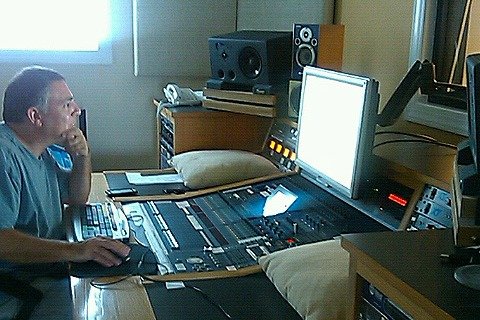In a quiet neighborhood in North Ocean City, just off a large canal and adjacent to a small residential park, sits a recording studio on par with anything owned by a major record label. This particular space cost over $300,000 to build, making it an anomaly in Ocean City, MD, and likely the whole Eastern Shore. However, this dwelling isn’t simply a state-of-the-art recording studio, it’s also an architectural office and the personal home of Steven J. Cirile; architect by trade, music producer by passion, and the owner of a modern day live/work space.
Spaces like Cirile’s are common in major metropolitan areas. Merchants often live in the apartments above their shops; artists and musicians convert lofts into both home and workspace. There’s even a movement across the country to rehabilitate dilapidated downtown areas in many smaller cities and towns. Local governments are enticing artists to relocate by offering properties for purchase with as little as a $1 price tag, in exchange for the artists to occupy, restore, and ultimately sell their wares out of the buildings. The forward-thinking mindset behind this type of movement is that new businesses in arts communities bring forth more revenue than run-down unoccupied spaces. But in Ocean City, MD, Cirile’s combined live and work dwelling stands largely on it’s own. The question then becomes, can a space like this, thrive in Ocean City, MD?
As an architect, Cirile is more aware of the trends in home design and functionality than most of the population. As a native New Yorker, he is well versed in the idea of artists living and working in the same space, and as a former musician, (a guitarist in a number of 80’s bands), he is certainly familiar with the idea of working out of someone’s basement studio. But times have changed. Cirile is a long ways away from the band member he used to be, and has obviously relocated from the “big city.” In fact, he’s certainly more in touch with what the live/work space is here, currently. Cirile can’t recall a residential project in recent memory that didn’t include a home office. But what Cirile ended up creating, when it came to designing his own live/work space, was something that even he didn’t intend.
Back in 2004, Cirile had just purchased a condo next to what is now the lot formerly known as the OC Health and Racquet Club, for a hefty price tag. The condo board presented a few months later a surprise “assessment” fee, to the tune of $35,000 for exterior repairs. In addition to the surprise fee, came the notice that if he elected not to pay, the condo association could take over his property, and sell it out from under him. He had no choice but to pay the assessment.
While living in the condo, Cirile also paid upwards of $850 a month for rent and utilities for an architectural office space rental. Cirile put the condo on the market, and once it finally sold, bought a lot in North Ocean City, intending to put a simple 1,000 sq ft dwelling on the lot. Then came the idea for a 400 sq ft addition for an architectural office, suggested by Cirile’s accountant to ease his monthly budget. After visiting City Hall to research building permits, Cirile found out the lot he purchased was zoned not only for an architectural design space, but also for a music studio, (among a long list of other limited traffic business enterprises). It seems he had found a location for both his primary business, and pet project. Cirile’s brother Michael is a sound engineer in the music business. On a regular basis he works with the industry elite, everyone from Elton John to the Black Eyed Peas. It was really a no-brainer that the Ciriles would put in the first ever cutting edge music studio in Ocean City, MD.
The home/work space was completed in 2008, after seven months of construction and going significantly over budget. As it turns out, to create an industry-quality recording studio in the middle of a residential neighborhood, it matters just as much about keeping sound out, as it does about letting it in. Cirile researched, and ended up spending $180,000 on sound proofing his second story studio. In addition to the 12 inch thick walls, a number of materials were employed to create a “room within a room,” soundproof space. The HVAC system had to be specialized to maintain zero noise, the dimmer lights, customized to emit not even a low-level hissing sound, were $2500 a piece, and the wiring at a price tag of $65,000 for zero interference with sound, was painstakingly installed. Cirile also invested as much as $180,000 on state of the art recording equipment. Putting a grand total on his music studio at upwards of $360,000.
Was it worth it? Cirile admits to knowing that the only way for a studio of this nature to truly succeed; (at least recoup investment expenses) is to have a major recording artist rent out his space for at least a month. And being in Ocean City, that hasn’t happened…yet. But, the architecture business has paid off, carries the space, and is Cirilie’s primary career. And, WAMU the Washington D.C.-based radio station that produces the Diane Rehm and Kojo Nnamdi shows, has an Ocean City affiliate station, and uses Cirile’s studio to produce their locally focused program, Coastal Connection. On the downside, Cirile anticipated that local bands would use his studio to record their demos, but due to the economy and in a town where the music industry is largely based on cover appeal, bands have little extra income to record their originals.
Admittedly, what Cirile envisioned for his studio hasn’t occurred. He needs a big band to find him, and call Ocean City home for a few months. Or, he needs an agent to sell the appeal of recording at his studio to bands who can’t afford to pay the astronomical city-prices.
What’s trending for the music industry now…record companies no longer paying out multi-million dollar record contracts, and all-expenses paid to the next big things in music; instead handing out ten grand for a record to be made, make small but lavish studios like Cirile’s poised to potentially make a large chunk of money. But, much like the music industry in general, it’s not what you have, it’s who you know. And until Cirile knows the right band to record there, he’s thankful for the architecture business, but equally as pleased that he gets to play to his passion every day. Cirile cops to loosing as much as eight hours in his music studio at a time, even forgetting to eat. There’s something to be said for personal happiness.
As Cirile puts it, any financial person will say that he’s crazy for investing that kind of money in a music studio. Even the largest names in the music studio business like the “Hit Factory” closed their doors…largely due to home-based operations like Cirile’s, who have all the best equipment, but charge a fraction of the regular fees. Even Aerosmith recorded their last two albums in the basement studio of their drummer.
Despite the slow crawl towards success for the music studio, Cirile absolutely believes in the convenience and freedom of a home-based business. The architecture space is successful. And Cirile’s even left room for expansion on the studio, just in case Bob Dylan or The Kings of Leon decide to show up one day. Or maybe, the mass appeal of recording an album close to the inspiring nature of the ocean takes off, and the next up and coming band makes Ocean City their home base for a spell. There’s real potential here, for something that may come. But it’s always hard being the pioneer.









